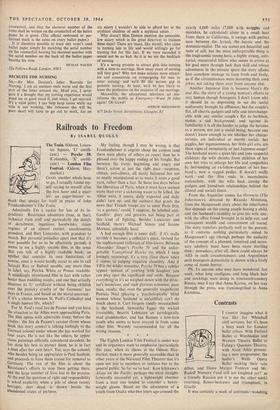Contrasts
I CANNOT imagine what it was like . for Whitehall civil servants, but it's been a busy week for London ballet critics. With Festival Ballet at Wimbledon and Western Theatre Ballet at Ealing's Questor•s Theatre, with Alvin Ailey present- ing a new programme, the
Sadler's Wells Opera Ballet making their solo debut, and Dame Margot Fonteyn and Mr. Rudolf Nureyev ('and still not knighted yet?' as a friendly Russian put it to me the other week) returning, flower-bestrewn and triumphant, in Giselle.
It was certainly a week of contrasts—watching
an arena-adapted Mods and Rockers battling it out in-the-round one afternoon, and then going on to the Royal Ballet, serenely and securely square in Giselle. It took all sorts last week, it even took the Sadler's Wells Opera Ballet making the least of their opportunities and crash- landing, if landing it was, on their first solo flight. (British ballet needs a strong vigorous ballet group at Sadler's Wells—and I could be wrong, but I fancy the Sadler's Wells Governors are not keeping to the terms of their charter if they do not provide one.) From the week as a whole some snapshots stand out—little Lucette Aldous of Festival Ballet curvetting through a new and strikingly vulgar version by Orlikovsky of the Lac pas-de- trois; Donna-Day Washington, Suzanne Hywell (marvellous as a Mod-girl shaking a Rocker-boy into quivering submission), Peter Cazalet and Simon Mottram, all four keeping the flag flying for WTB; Nureyev, having invented a fiendishly difficult and diabolically ineffectual solo for him- self in Giselle, still winning through because he knows (as does no one, comparatively, else) that Romantic agony is not just an expression that crosses your face when someone steps on your corns; young Desmond Kelly, dancing with cal- culated brilliance and Irish charm as Peer Gynt in Festival Ballet's extravaganza of the same name, and then hiding, a little disappointingly, behind an old man's make-up, as if unwilling to come out and act. And then there was Ailey and his dancers at the Shaftesbury.
Ailey has produced a revised programme for the remainder of the season (which continues for another fortnight) and this is far superior to his first London offering. The weak opening item, so much like slick cabaret, has been aban- doned. and in its place come two major modern dance works, The Road of the Phoebe Snow and The Beloved.
Phoebe Snow is a story ballet without a fully connected narrative, and is cyclic in structure, beginning and ending with the suicide of a- girl who has been raped. Beatty (a former dancer with Katherine Dunham) has chosen to make his ballet into a dance suite of mood rather than specific incident, even although the ending, with a boy, a girl and a local bully, proves con- clusively coherent until the final suicide plunge.
The title is taken from the name of a railroad (those potent evokers of Negro mythology) run- ning through the town where Beatty was born. Beatty's ballet is inspired by Negro gang-life during his adolescence, and the ballet has some- thing of the same powerful quality as Robbins's N.Y. Export: Opus Jazz. But Beatty:s blend of classic, modern and jazz choreography danced to Ellington/Strayhorn music is nothing but itself —febrile, anguished and moving at a continued pitch of crisis. It is marvellously danced through- out, particularly by William Louther.
Lester Horton's The Beloved, together with another Horton duet To Jose Clemente Orozco (given for the first time on Saturday), shows Horton to be a choreographer of considerable interest. Hortoh died twelve years ago, after a lifetime of work in Los Angeles. Out of the main- stream of dance it has taken some time for his teaching and work to penetrate to New York, and now London. Joyce Trisler and James Truitte, who dance The Beloved, were both Hor- ton students, as was Ailey himself.
The Beloved is a duet of impassioned for- mality. A man and woman confront one another over a New England breakfast-table, the tensions between the two (the religious fanatic of a hus- band, the humbly servile wife) build up, until the woman is murdered. Impressive, even horrifying, it is all carried out with choreography of startling expressiveness. The Orozco duet is a more elusive yet also beautiful thing—dedicated to the great Mexican painter and danced by Trisler and Ailey, it is a dance with shifting moods of light and shade. Both of them offer an arrestingly personal movement style quite new to Britain.
CLIVE SARNES



































 Previous page
Previous page